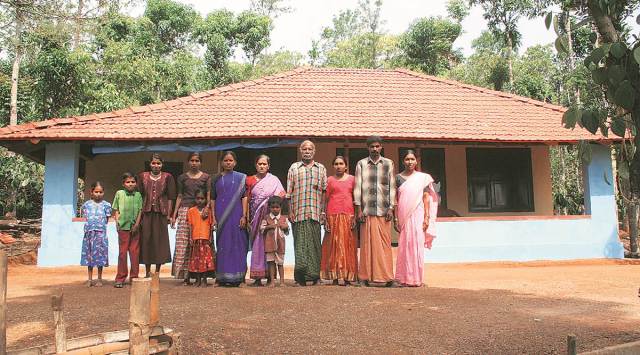- India
- International
Four years after elephant corridor secured in Wayanad, rise in animals, incomes
South India has 28 corridors that are essential for the movement of its 14,612 elephants between protected areas.
 A family from Thirulakunnu village that was encouraged to move out and relocated elsewhere. Pic courtesy: (Source: WTI)
A family from Thirulakunnu village that was encouraged to move out and relocated elsewhere. Pic courtesy: (Source: WTI)A REPORT released by the Wildlife Trust of India (WTI) last month shows that four years after the Thirunelli-Kudrakote elephant corridor in Kerala’s Wayanad district was accorded protection by the state, unencumbered elephant movement in the corridor has increased, as has the presence of other species in the area, including tigers and spotted deer.
The Wayanad corridor, initiated by the Kerala government nearly 15 years ago in association with the WTI and several other national and international NGOs, is the first of its kind in South Asia, wherein villagers living directly in the path of the elephant movement were encouraged to voluntarily move out and were relocated elsewhere.
The 2,200-acre Thirunelli-Kudrakote corridor is located in the tri-junction of Karnataka, Kerala and Tamil Nadu. In all, 37 acres were secured to ensure that this corridor remains unbroken, linking 6,500 elephants, as well as other species.
Enthused by the project’s success, the Kerala government has initiated a process to “acquire and secure” all elephant corridors in the state. “There are seven elephant corridors in Kerala. Of these, two are already secure and need no land acquisition. One has been secured for us by the WTI. We have initiated acquisition in the remaining four corridors and plan to escalate the process,” Principal Chief Conservator of Forests and Chief Wildlife Warden, Kerala, Surendra Kumar said.
Opinion| Policy lessons from the elephant death in Kerala
The biggest win in the Wayanad project remains the relocation. The 200-odd villagers who were relocated to ensure the unbroken corridor have been provided pucca houses, in lieu of the thatched huts they lived in earlier, and also have the assurance that their crops would not be destroyed by elephants. Before they were moved, roads were constructed, power lines laid and water facilities provided in the new areas.

The WTI report says the villagers have testified that they are no longer in conflict with the elephants and that their annual income has actually gone up from Rs 41,040 per annum per family to Rs 1,75,080. Apart from the saved crops, access to market facilities and jobs has also facilitated the increase in income. The new villages are closer to health centres and schools. Villagers have been coming forward for vaccinations, and even illiteracy among them has seen a decline from 33 per cent to 28 per cent, notes the report.
In another success for the project, several years ago, the Forest Department captured its first tiger movement in the corridor on its camera traps. The last sighting was in March.
The 37 acres to secure the Thirunelli-Kudrakote corridor fall between the protected areas of the Brahmagiri Wildlife Sanctuary and Wayanad Wildlife Sanctuary. While 25.3 acres were acquired on a private purchase model by the WTI, the Asian Nature Conservation Foundation secured the remaining 12 acres and handed over the land to the Kerala Forest Department, a process that took around a decade.
The WTI report says that even in the initial stages of consultation, the villagers of Thirulakunnu themselves asked to be relocated. Villagers who did not want to be moved were not forced to, such as those in Edayur Vayal, who continue to stay where they were.
Apart from Thirulakunnu, Valiya Emmadi, Kottapady and Puliankolly villages were entirely relocated. Villagers of Sulthar Vayal were not relocated, but land was acquired and they were given alternative agricultural plots.
The land in the corridors to be linked now would be directly acquired by the Kerala Forest Department, the Principal Chief Conservator of Forests said.
“The Thirunelli-Kudrakote corridor is one of the most important ecologically. South India has one of the highest populations and concentrations of elephants and this corridor connects some of the biggest elephant-inhabited areas. When an elephant corridor is fragmented, then elephants cannot migrate and this leads to inbreeding and genetic isolation. When that happens there is a big chance of the population declining,” the WTI’s Officer In-Charge, Corridors, Upasana Ganguly, who has been involved with the Wayanad project, said.
Ganguly added that the project took this long because of its sensitive nature and care was taken to ensure that only those villages which fell directly in the path of the elephants were relocated.
South India has 28 corridors that are essential for the movement of its 14,612 elephants between protected areas.
Annually, India sees 450 deaths in encounters with elephants, with at least 500,000 families affected due to the man-animal conflict. Elephants are estimated to damage 0.8 to 1 million hectares of crops every year. At least 100 elephants are known to be killed annually in the conflict.
Apart from its flagship Asian elephant, the Wayanad Wildlife Sanctuary has 45 species of mammals, including tigers, Sambhars, sloth bear, common leopards, Gaurs, spotted deer, Grey Langurs, the Bonnet macaque and the Malabar giant squirrel. The sanctuary houses 227 bird species, accounting for 48% of the total bird species in the state.
Apr 26: Latest News
- 01
- 02
- 03
- 04
- 05








































